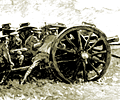|
Grade 10 History
Introduction
Time frame: approximately two to three weeks
Author:
Mindy Poley, Coreen Kieser
- Aim:
- To familiarize students with both the causes of, and Canada's involvement
in World War I. By focusing on factors contributing to change in society
(technology, politics, war), students will focus on the impact of World
War I on both Canadians and the Global Community.
Rationale:
- By studying the First World
War, students can begin to place their country within a global context.
They are given the opportunity to explore and understand bias, and differentiate
between fact and opinion. By exploring propaganda tools, students will
develop critical thinking skills. Through various frameworks, students
will begin to develop an understanding and appreciation of veterans accomplishments
and sacrifices. This unit works to connect students to many communities,
and develop further their understanding of Canada's place in the global
community.
- Expectations:
- By the end of the unit, students will...
-
demonstrate an understanding of how diverse groups and individuals
have contributed to the historical, cultural, and economic development
of Canada.
-
analyze and describe the conflicts and changes involving Canadians
in World War I.
-
demonstrate an understanding of the impact of WW I on Canada and
the World community.
-
identify and describe the achievements of Canadians who have contributed
significantly to the development of Canada and the world.
-
demonstrate an understanding of Canada's participation in World War
I (e.g., reasons Canada fought, roles of Canadian men and women, actions
of the Canadian forces at the battle of Vimy Ridge) and the contributions
of war veterans to Canada and world history.
-
demonstrate an understanding of the impact of World War I on the
veterans, their families, Canada as a whole and specific groups within
the country.
-
use appropriate vocabulary to describe their inquiries and observations.
-
formulate questions to facilitate research (e.g., the changing role
of women in the workforce), using a variety of sources;
-
analyze, synthesize, and evaluate historical information; locate
information using a variety of sources.
-
analyze and describe conflicting points of view.
-
communicate the results of inquiries for specific purposes and audiences,
using media works, political cartoons, oral presentations, written notes,
reports, posters, tables, charts, and/or graphs.
-
differentiate between bias, inference, and fact.
|











